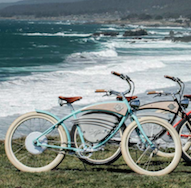It’s time to accept that e-bikes are here to stay. The battery-powered pedal bikes already account for the fastest growing area of the cycling industry, and new products are hitting the market seemingly every day. Still, sifting through the mire of EU legislation to define what is and isn’t technically legal, and therefore what will sell well in the UK, is an incredibly daunting prospect.
Those who have been following the developments in the market will be aware that as of April 2015, the British e-bike laws were altered to create stronger and more unified EU-wide regulations. In this move, which came into effect in early 2016, the bare bones of these new regulations centered on increasing the maximum power of an EAPC (electrically assisted pedal cycle) motor from 200 watts, up to 250 watts, whilst simultaneously setting the new nationwide pedal-assist speed limit to 15.5 miles per hour, as per the standard on the continent.
Beyond the 15.5mph (a direct conversion from 25 kph) speed limit for pedal assist bikes, any assistance must automatically cease, rendering the bike once again a purely pedal-powered machine. This is also the case for throttle control (or twist and go) bikes. The new laws do not affect twist throttles with walk-assist mode – which powers the bike to a 6kmh limit, or “walking speed” – while pedals are in motion. Legally however, twist throttles beyond the walking speed limit may only be in use when the pedals are in a forward motion. For those of you raising your hands in despair at the prior purchase of an expensive e-bike, these laws are not backdated – your bike is legal so long as it pre-dates the introduction of the January 2016 changes.
When these laws are abided, the bike is classified as a normal bicycle, and therefore can be used both on roads, and on any ground legally branded a cycle path. A major exception to this rule is the age laws, which prohibit anyone under the age of 14 to ride an e-bike anywhere apart from on private land. Users above this age limit do not require any form of license or road tax.
Disabled users, or those who simply enjoy riding on three wheels, fear not, trikes are very much included in these laws and as such EAPCs are permitted to have three or more wheels with no legal complications. In fact, owning an e-trike has become simpler, with the removal of a 60kg weight restriction.
Obviously, safety standards are extremely important, and the official safety standard for pedelecs in force across Europe is EN15194, which when followed, deems e-bikes to be safe and fit for public purpose. This however only applies to the electric part of the vehicle (for the rest of the bike, the safety standard is EN14764). It’s worth noting that all bikes that pass the legal requirement for testing are issued with a certificate of compliance from the testing house, which is a good quality assurance sign when purchasing.
As demonstrated by the mass of high-powered e-bikes on display at the 2016 Interbike convention in the USA, the regulations over the pond differ greatly to those in Europe. In 2001, a bill was passed that officially defines and categorises e-bikes in federal law. This new bill exempts electric bikes with operating pedals and a motor under 750 watts (limited to 20mph) from the legal definition of a motor vehicle. The e-bike definition set out in this bill is significant because this means that unlike motorbikes, the Consumer Product Safety Commission regulates production.
Whereas this system may seem relatively straightforward, dealers and riders in the US are also governed by individual state laws, which massively vary depending on state and governing body. According to a recent study, up to 30 states are still in the processes of technically defining e-bike regulation. Lobbying bodies such as the People-For-Bikes Product Suppliers Association are currently partnering with local advocacy groups, and are working towards streamlining state regulations, but this process is far from completion.
The mire of baffling US legislation is made even more confusing due to the introduction of various other classifications for bikes, such as a speed pedelec, which technically meets the bicycle definition for a 20mph e-bike, but is designed to max out at 28mph. This classification is due to a loophole of sorts, which states that e-bikes can achieve speeds of 20mph “on motor alone.” As such, a speed pedelec achieving speeds of 28mph by applying leg power to the motor assist isn’t breaking the law, regardless of how little this is contributing to the motor.
In Europe and the UK, the future of the e-bike market is bright. Policed legislation is ensuring the production of a high-quality output, which looks set to instil confidence in those who are on the fence about the concept, as demonstrated by the rising number of active users on the continent. However, the concept of unified legislation is still to be completely embraced in the US, as electric bike companies do their best to feel out the mire of federal versus state legislation. Regardless of the current confusion, lobbying groups are making significant headway into strengthening state law, and by doing so, helping thousands of people enjoy what is fast becoming a culture of cleaner, more efficient transport.
 BikeBiz Bicycle and cycling retail news
BikeBiz Bicycle and cycling retail news




